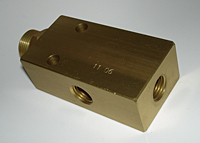- Messages
- 8,632
- Reaction score
- 7,343
- # of dives
- 2500 - 4999

Tauchkompressor-Füllservice Hochdruck-Füllstation mit M16*1,5 oder 7/16-20UNF Nachfüllventil mit Hochdruckschlauch - AliExpress 18
Smarter Shopping, Better Living! Aliexpress.com
Welcome to ScubaBoard, the world's largest scuba diving community. Registration is not required to read the forums, but we encourage you to join. Joining has its benefits and enables you to participate in the discussions.
Benefits of registering include


Tauchkompressor-Füllservice Hochdruck-Füllstation mit M16*1,5 oder 7/16-20UNF Nachfüllventil mit Hochdruckschlauch - AliExpress 18
Smarter Shopping, Better Living! Aliexpress.comwww.aliexpress.com
Well shoot. There is a strip in the housing that says it turns colors when depleted. Per the strip the filters are still ok. Unfortunately I left them uncovered because there was moisture in the aluminum housings. The compressor is 35 mins away and I’m heading out for a week trip. Hopefully I can find the time.
It’s 14CFM @ 6000psi.
Can you tell if this is my PMV? It’s described as back pressure regulator. Seems it might be the same thing just different terminology. pic attached, link below.

211 Back Pressure Regulators On Aqua Environment Co., Inc.
Browse 211 Back Pressure Regulators in the Aqua Environment Co., Inc. catalog including Item #,Special Features,Maximum Rated Pressure,Outlet Pressure Setting Range/Adjustment Range,Inlet Port Size,Weight,Overall Length,List Price,Flow Coeffivalvesandregulators.aquaenvironment.com
One of those numbers is wrong .... (Typo)[snip]
I really try to keep ambient below 70. That's not the temperature that reaches the filter, Bauer states that the rise is ~ 18F after the compressor. So 70F will net ~ 78F at the filter!
And that's what happens when I try to type too fast! Good call.One of those numbers is wrong .... (Typo)
You're much better off tracking how many hours you're running and how many cf that equated to. Change filters as needed. Attached is a spreadsheet someone posted on here that I really like. The important parts are temp and hours run. You have to plug in what your compressor is rated at along with how many cf your filter can handle. This is nice because when you plug in ambient it will calculate the amount of filter life you have left. The higher the ambient the faster you'll run through filter life.
I really try to keep ambient below 70. That's not the temperature that reaches the filter, Bauer states that the rise is ~ 18F after the compressor. So 70F will net ~78F88F at the filter!
If it's not the author of the (awesome) spreadsheet himself!
Are you using 1/4” PCP fittings? Seems everything is 1/8” that I’m coming across.Hope this helps.
I don't mind pcp fittings, don't seem as popular here on scubaboard.
But I don't mind it. Plus the hoses are low bore. And quite flexible.
And if you want a transfer whip just a matter of quick connecting a hose or two to your fill adapters
